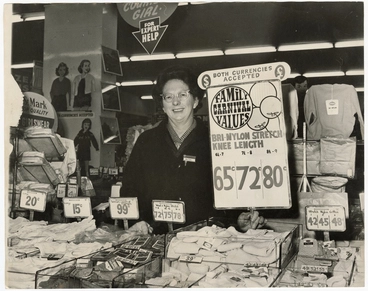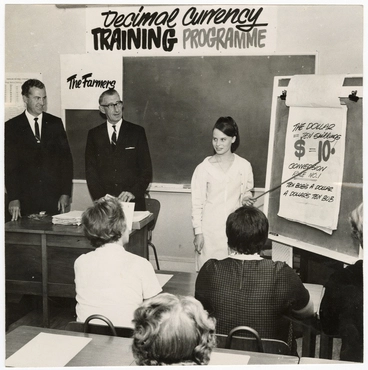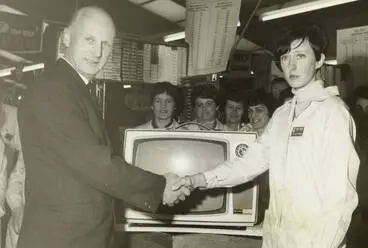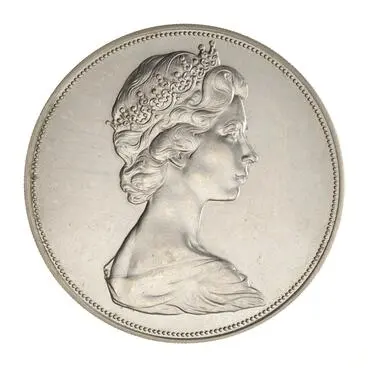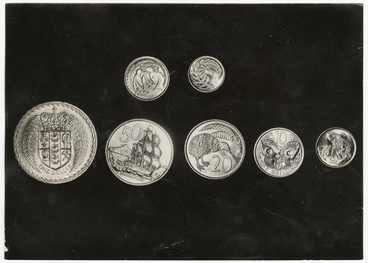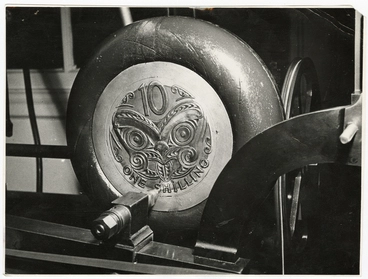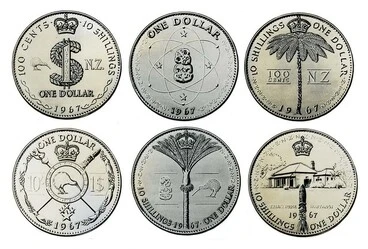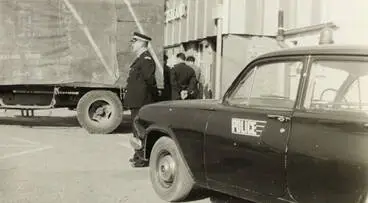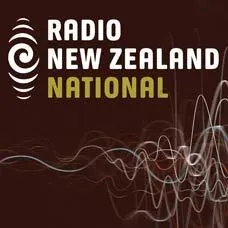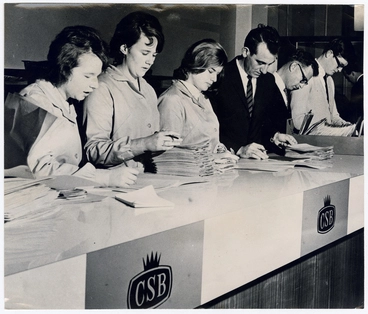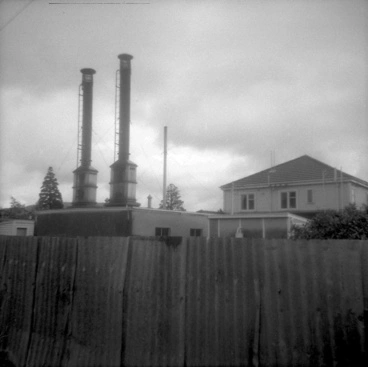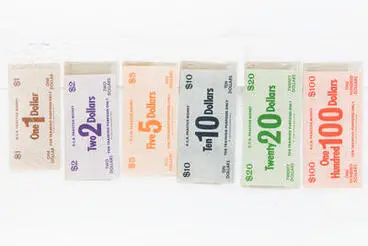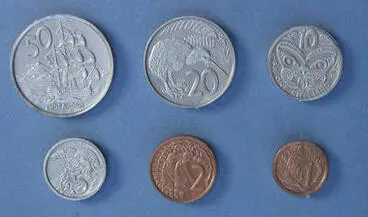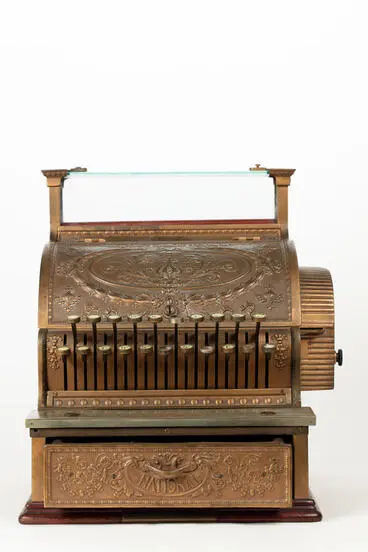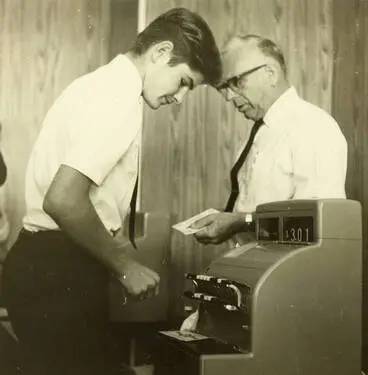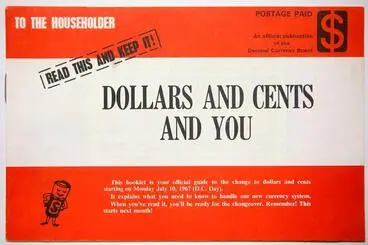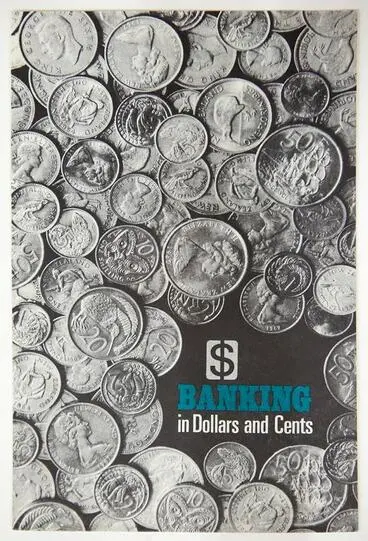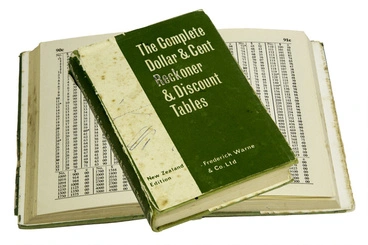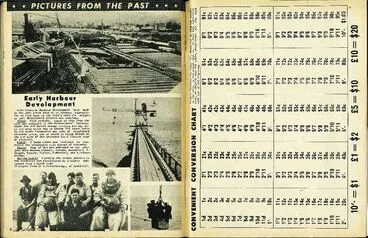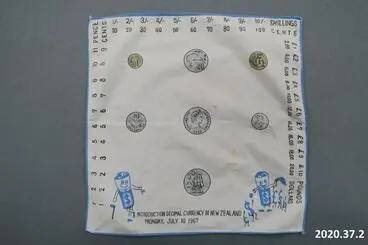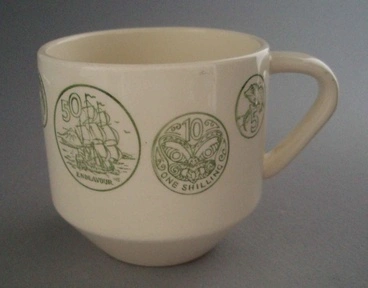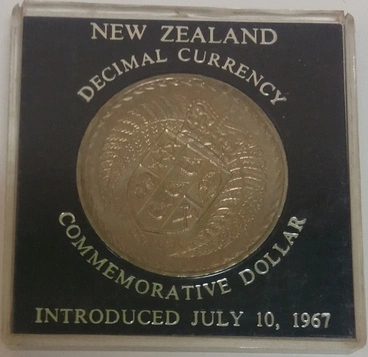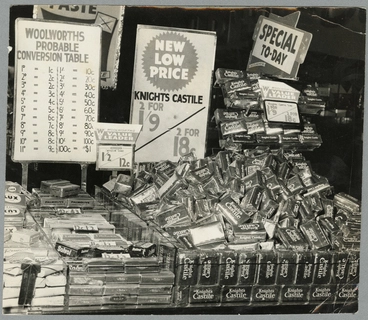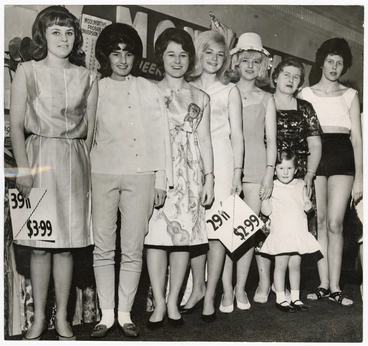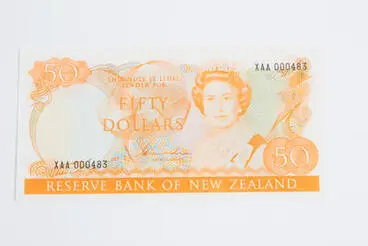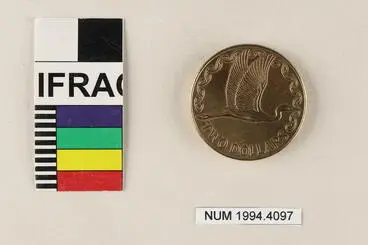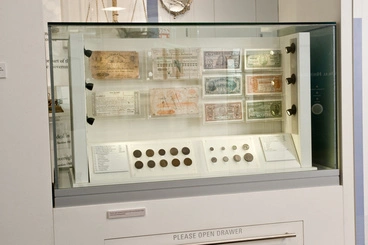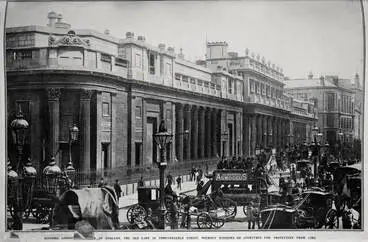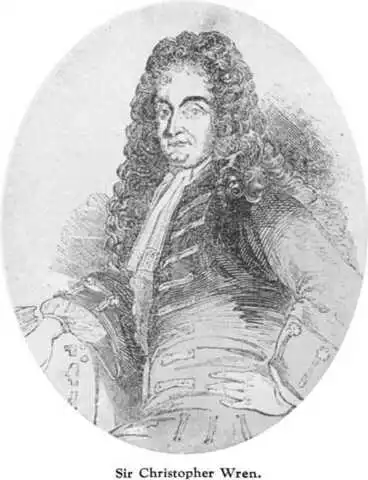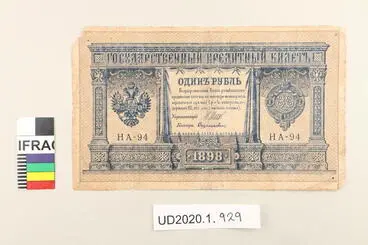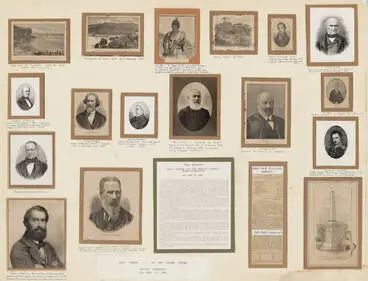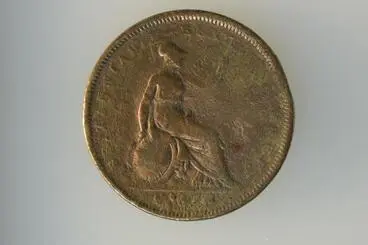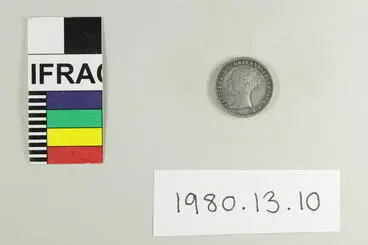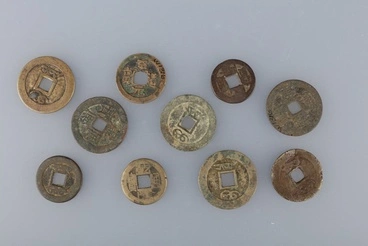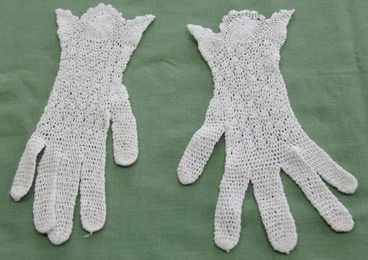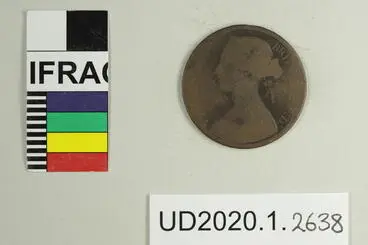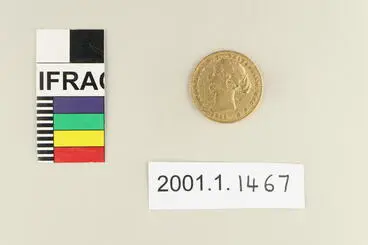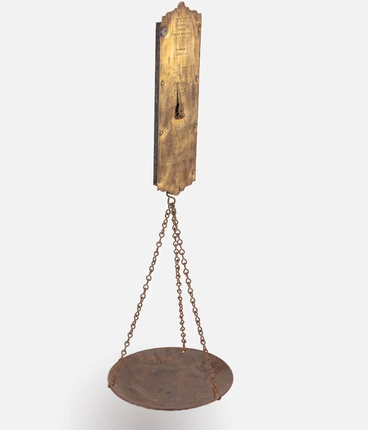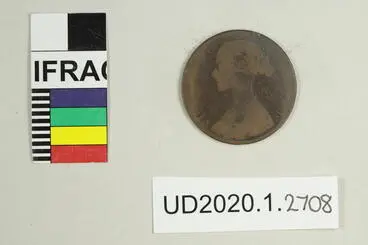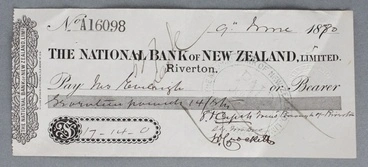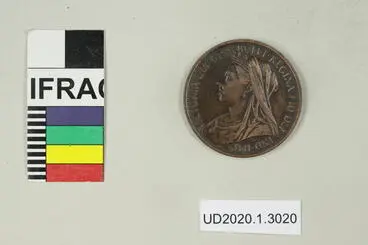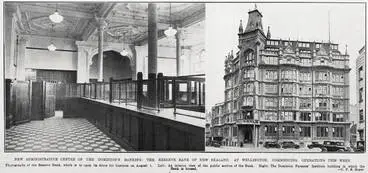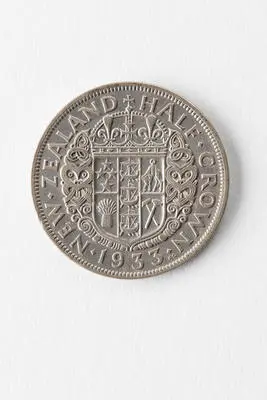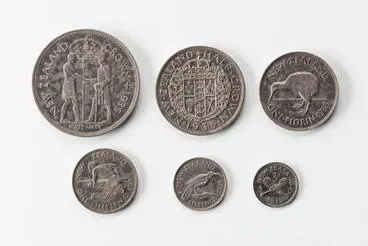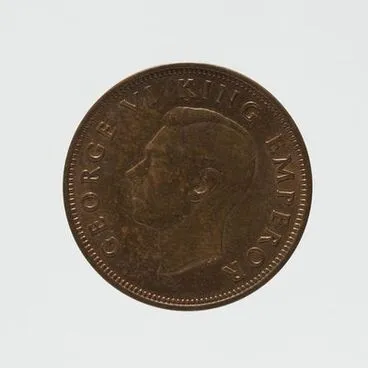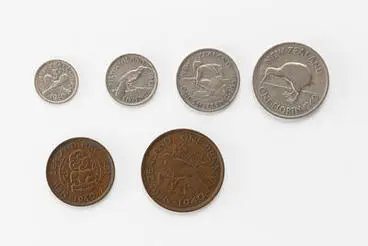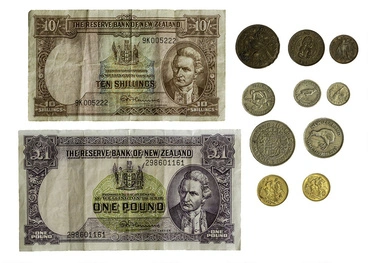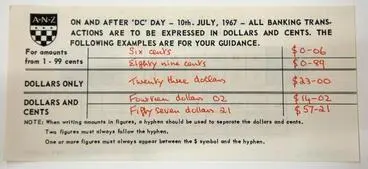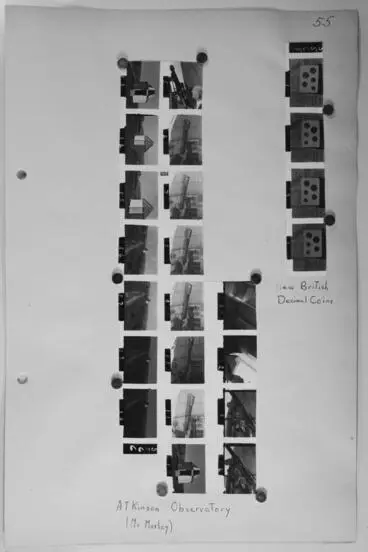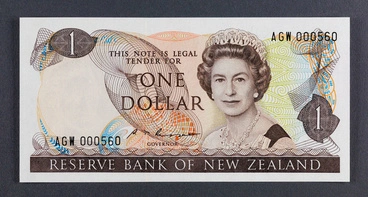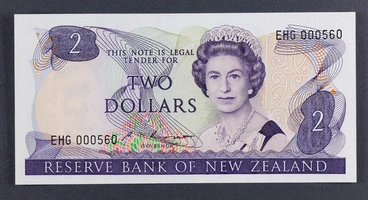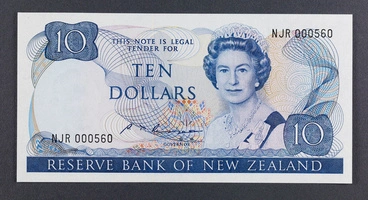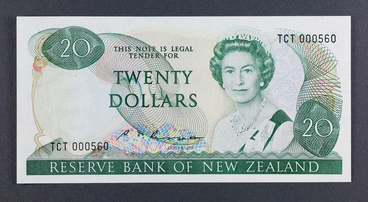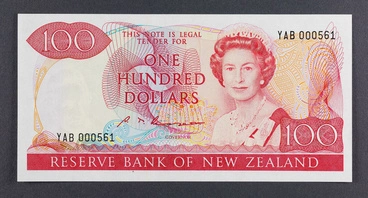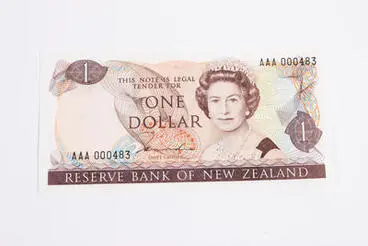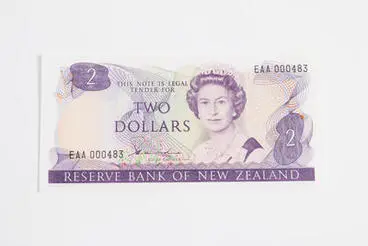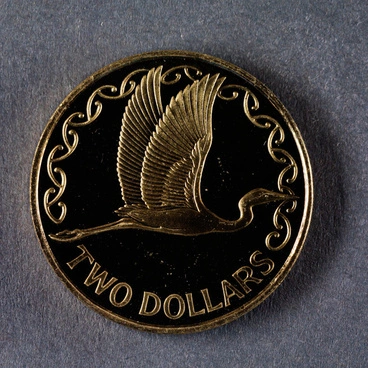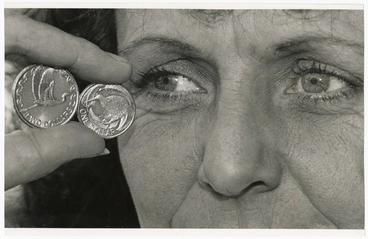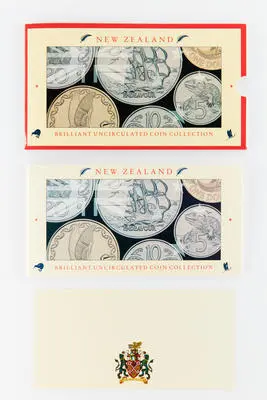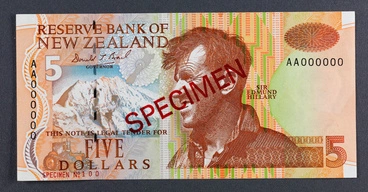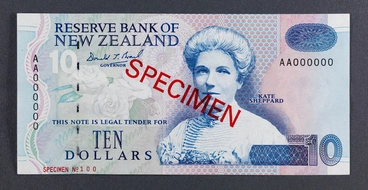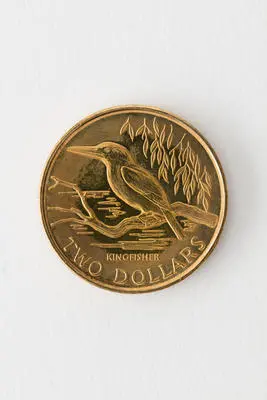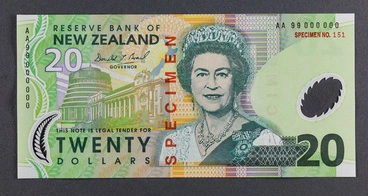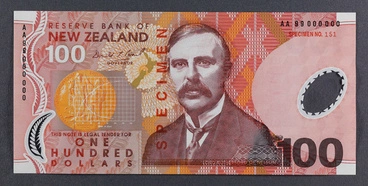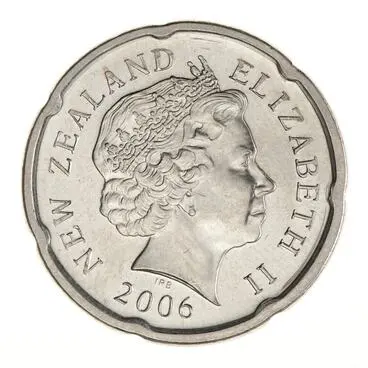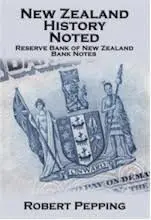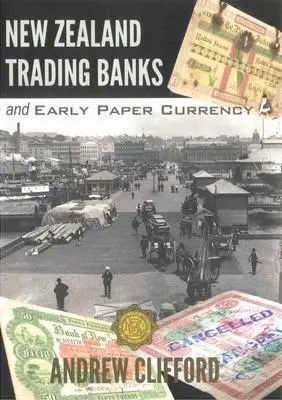On 10 July 1967, New Zealand began using decimal currency whereby dollars and cents replaced the British sterling currency of pounds, shillings and pence. The term ‘decimal currency’ derives from the Latin word 'decem', meaning ten, and describes any currency that can be divided into smaller units by dividing by ten or a hundred. The origin of decimalisation and the metrics system of weights and measurement is historically thought to be attributed to the fingers on people's hands numbering ten, thus aiding counting.
A behind-the-scenes summary is given on the designing of NZ's decimal notes and coins following a public competition; the using of the mascot "Mr Dollar" in a nationwide public education campaign; and the training of bank staff, businesses, and the general public to use the new currency from 'DC Day' onwards.
A 'backstory' overview is also given of the early advocates of decimalisation and the first countries to adopt the decimal system. The journey of NZ from using overseas currency to issuing its own pounds, shillings and pence; its eventual move to decimalisation; and subsequent changes in its dollars and coins since 1967, are also described.
On 10 July 1967, decimal currency was introduced in NZ with dollars & cents replacing pounds, shillings & pence
Decimal system was thought easier than sterling system where 1 pound = 20 shillings or 240 pence & 1 shilling = 12 pence
Christchurch City Libraries
The 'Decimal currency' jingle with the mascot 'Mr Dollar' to promote the changeover date ('DC Day') featured on TV
“Don’t shed a tear in July next year, for cumbersome pounds and pence,” the decimal currency song sang from mid-1966
Manatū Taonga, the Ministry for Culture and Heritage
Initially, $1, $2, $5, $10, $20 & $100 banknotes & 1, 2, 5, 10, 20 & 50 cent coins were issued
Later on, NZ Introduced $50 note (1983) & $1 & $2 coins (1991); & withdrew 1 & 2 cent coins (1990) & 5 cent coins (2006)
Upper Hutt City Library
Training on decimal currency was given to banks & businesses
Christchurch City Libraries
Certificates were issued to schoolchildren who had "attained a satisfactory knowledge of Decimal Currency"
The recipient was entitled to be called a Dollar Scholar & the certificate was signed by Mr Dollar
Alexander Turnbull Library
The first day New Zealanders began using decimal currency was likened to a rugby match by a cartoonist
Alexander Turnbull Library
For being the best cash-handler and currency converter at Self Help Stores, the checkout operator was awarded a TV set
(Photograph was published in the South Auckland Courier Central Edition, 30 August 1967, p. 3)
Auckland Libraries
Sterling currency was withdrawn from circulation
Image: Mr E D Vallence of Reserve Bank feeds the furnace with redundant pound sterling banknotes worth $760,000 (1968)
Alexander Turnbull Library
>>>>>>>>>>>>>>>>>>>>>
1. Behind-the-scenes: From designing the decimal currency to NZ's 'DC Day'
Decimalisation was overseen by Robert Muldoon who'd been appointed Under-Secretary to Minister of Finance in 1964
He was later appointed Associate Minister of Finance in 1966; Minister of Finance in 1967; & PM from 1975-1984
Alexander Turnbull Library
The Decimal Currency Board was formed to manage the conversion from sterling to decimal currency
The Board delegated the development of denominations to the Coinage Design Advisory Committee (CDAC)
Tauranga City Libraries
Name suggestions for the new currency included 'dollar', ‘crown’, ‘fern’, ‘tūi’, 'royal', 'doubloon', & 'zeal'
{Image: Cartoonist's alternative names included "All Black", "Whinerary", "sheep", "hen's teeth", but not "zeal")
Alexander Turnbull Library
Term 'Dollar' was chosen which was the most popular in a newspaper poll & had been adopted by Australia in Sept 1963
(Australia had chosen 'dollar' when making its preparations to switch to decimal currency on 14 Feb 1966)
Tauranga City Libraries
The Decimal Currency Act (3 Nov 1964) set out the designs, diameters & standard weights of the decimal coins
Denominations of 1, 2, 5, 10, 20 & 50 cent coins & 1 dollar coin were developed by the Coinage Design Advisory Committee
Auckland War Memorial Museum Tāmaki Paenga Hira
In 1965, the Cabinet approved the 'heads' side of the coins with Queen Elizabeth II's portrait by Arnold Machin
As with tradition, the ‘heads’ side showed the reigning monarch, & were minted by the Royal Mint, Llantrisant, Wales
Museums Victoria
For 'tail' side, the Committee appointed 14 artists after its public competition had 156 people submit 624 designs
The Cabinet then selected the designs by 5 of the artists to send to the Royal Mint for approval
Alexander Turnbull Library
When the Cabinet-approved designs were rejected by Royal Mint in Nov 1965, 5 more artists were asked to submit designs
Drawings sent to Royal Mint were leaked to media & public response was negative. (Image: Designs rejected for 20 cent)
Manatū Taonga, the Ministry for Culture and Heritage
In March 1966, the Committee published all the designs for the public to vote on using voting forms in newspapers
(Cartoon: Householder had prioritised filling out voting form for coins during the same period as census data gathering)
Alexander Turnbull Library
The design concepts by James Berry were favoured by the public & the Govt; & were approved by Royal Mint in March 1966
The Committee decided to use Berry's designs for 1, 2, 20 & 50 cents; adapt the 5 & 10 cents; & not use 1 dollar coin
Christchurch City Libraries
The Committee suggested that Berry switch the tuatara on his 10 cent coin to the 5 cent coin
Christchurch City Libraries
The Committee also suggested that Berry adapt for the 10 cent coin the Māori motif designed by Francis Shurrock
The word 'shilling' was also included on the 10 cent coin until 1970 to help people make transition to decimal currency
Christchurch City Libraries
The initial plan for a one dollar coin, for which Berry was commissioned to create designs, was changed to a $1 banknote
Archives New Zealand Te Rua Mahara o te Kāwanatanga
The Committee designed the $1, $2, $5, $10, $20, $100 in consultation with London banknote printers Thomas De La Rue
The $50 note was not introduced until 1983. (Image: Two Committee members)
Alexander Turnbull Library
Colour scheme was same as the equivalent pound notes for ease of transition except for new $5 note, & note sizes varied
Reverse side of the brown $1 note (140 × 70mm size) had a fantail & NZ clematis.
Manatū Taonga, the Ministry for Culture and Heritage
The banknotes featured Queen Elizabeth II's portrait which was based on a 1960 photograph by Anthony Buckley
The reverse side of the purple $2 note (140 × 70 mm size) featured a rifleman (native bird) & the red mistletoe
Manatū Taonga, the Ministry for Culture and Heritage
The reverse side of the orange $5 note (150 × 75 mm size) featured a tūī & kōwhai
Third series of banknotes: $5
Manatū Taonga, the Ministry for Culture and Heritage
The reverse side of the blue $10 note (155 × 77.5 mm size) featured the kea & the Mt Cook lily
Third series of banknotes: $10
Manatū Taonga, the Ministry for Culture and Heritage
The reverse side of the green $20 note (160 × 80 mm size) featured a kererū & a flowering branch of the miro tree
Third series of banknotes: $20
Manatū Taonga, the Ministry for Culture and Heritage
The reverse side of the red $100 note (160 × 80 mm size) featured a takahē & mountain daisy
Third series of banknotes: $100
Manatū Taonga, the Ministry for Culture and Heritage
>>>>>>>>>>>>>>>>>>>>
The new decimal currency worth $120 million & weighing more than 730 tonnes was shipped in crates to NZ
The new currency totalled 27 million banknotes & 165 million coins
Alexander Turnbull Library
$112 million worth of notes & $8 million in coins were delivered to 592 bank branches around NZ during April-June 1967
The design of the notes was not publically made known until June 1967 to thwart counterfeiters
Canterbury Museum
Police & Army officers accompanied the delivery of the currency
(Image: Currency being delivered by truck to BNZ's Manurewa branch)
Auckland Libraries
Decimal currency was also transported by six special trains around NZ
RNZ interview (19 July 2027) with David Parsons about the "Decimal Express" (23:20 mins)
Radio New Zealand
The National Film Unit produced "Operation Overlander" (1:05 min) on the delivery by plane, ferry, truck & train
Manatū Taonga, the Ministry for Culture and Heritage
NZ National Film Unit (1967): 'Now it can be told" shows the security rollout of decimal currency across NZ (3.59 min)
Clip is part of Pictorial Parade No. 194
Archives New Zealand Te Rua Mahara o te Kāwanatanga
>>>>>>>>>>>>>>>>>>>>>
The banks were closed from 3pm on Wed 5 July to give staff time to convert their records by 10am on Mon 10 July
From 10 July, every bank deposit slip, cheque & withdrawal form had to use the terms dollars and cents
Christchurch City Libraries
Behind-the scenes photos of banks changing over to the new currency were captured by Nelson Photo News, 22 July 1967
Nelson Photo News
The sterling currency was withdrawn from circulation
Image: Furnaces at the Reserve Bank's Upper Hutt premises which were used to incinerate banknotes
Reserve Bank of New Zealand
>>>>>>>>>>>>>>>>>>>>
Staff at banks were given training on the changeover to decimal currency
Upper Hutt City Library
Sets of decimal currency practice banknotes were issued to help train bank clerks
Auckland War Memorial Museum Tāmaki Paenga Hira
Sets of six plastic NZ decimal currency play money were also produced
The 5 cent coin was the same size & composition as the old sixpence coin it replaced to ease the transition
Auckland War Memorial Museum Tāmaki Paenga Hira
Training sessions for bank staff included acting as tellers & customers
Upper Hutt City Library
Cash registers for pounds, shillings & pence were replaced with new cash registers
New Zealand Maritime Museum
Training was given on how to use the new decimal currency cash registers
Auckland Libraries
Training classes were also held by businesses
Upper Hutt City Library
During 1967, the animated commercial "Decimal Currency Changeover" (30 secs) with Mr Dollar was shown on TV
NZ On Screen
A Māori ‘Mr Dollar’ was also designed which was distributed by Dept. of Māori Affairs
Cover: 'Dollars and cents / New money for New Zealand / It will come into force on 10 July 1967'.
Manatū Taonga, the Ministry for Culture and Heritage
Animated "Shopping with decimal currency" (21 secs) advert was also shown on TV
Grandmother & grandson buying 16 cent cabbage: “Just offer a little more and you’ll get the right change everytime"
Ngā Taonga Sound & Vision
Booklet "Dollars and cents and you" produced by the Decimal Currency Board
Waikato Museum Te Whare Taonga o Waikato
Booklet "Banking in dollars and cents" produced by the Decimal Currency Board
Waikato Museum Te Whare Taonga o Waikato
Ready reckoner book: "The complete dollar and cent reckoner & discount tables"
Published by Frederick Warne & Co Ltd
Mangawhai Museum
Booklet: "Decimal currency; introduction into New Zealand schools; suggestions for teachers" by Dept of Education, 1966
Auckland War Memorial Museum Tāmaki Paenga Hira
Currency conversion chart was printed by the Gisborne Photo News (Issue No 156, 14 June, 1967)
Gisborne Photo News
This tea towel, which features 'Mr Dollar', was issued with the sanction of the Decimal Currency Board
Museum of New Zealand Te Papa Tongarewa
This linen towel showed the new coins & provided a conversion table, overseen by 'Mr Dollar'
Manatū Taonga, the Ministry for Culture and Heritage
Handkerchief printed with coins & anthropomorphised money around edges to aid transfer from sterling currency
Tairāwhiti Museum Te Whare Taonga o Tairāwhiti
Commemorative cup with decimal currency (1c, 2c, 5c, 10c, 20c & 50c) was produced by Crown Lynn Potteries Ltd
Te Toi Uku, Crown Lynn and Clayworks Museum
New Zealand Decimal Currency Commemorative Dollar was produced
On the front is a crowned shield within silver fern leaves. On the back is Queen Elizabeth II.
New Zealand Cricket Museum
>>>>>>>>>>>>>>>>>>>
On 10 July 1967, the exchange of dollars and cents by the public began
(Image: An auction held on 10 July 1967 where bidding was in dollars & cents was published in Bay of Plenty Times)
Tauranga City Libraries
Stores, including Woolworths, displayed decimal conversion charts
Christchurch City Libraries
Models at Woolworths store on High Street, Christchurch with tags in sterling & decimal currency
Christchurch City Libraries
One-page promotional flyer with a quiz & prize at the Hazelwoods department store
Shoppers could win back the cost of their purchased items by answering a quiz about decimal currency
Upper Hutt City Library
An employee's first pay packet of dollars & cents (Bay of Plenty Times, 13 July 1967)
Tauranga City Libraries
>>>>>>>>>>>>>>>>>>>
In 1983, the $50 note was introduced
Nowadays: $5, $10, $20, $50 & $100 banknotes are legal tender
Auckland War Memorial Museum Tāmaki Paenga Hira
In 1991, $1 & $2 coins were introduced to replace the one & two dollar banknotes
Canterbury Museum
The one & two cent coins ceased as legal tender on 30 April 1990, & the 5 cent coins ceased on 1 Nov 2006
Nowadays, 10 cent, 20 cent & 50 cent coins & $1 & $2 coins are legal tender
Alexander Turnbull Library
The Reserve Bank of New Zealand has a numismatic collection of historical & current banknotes & coins
Reserve Bank of New Zealand
>>>>>>>>>>>>>>>>>>>>>>>>>>>
2. Backstory:
A. 1530s-1810s: Early advocates of decimal currency
Decimalisation had been the subject of debate for centuries in Europe and America. Mathematicians, economists, philosophers and parliamentarians considered the merits of adopting the metric system for weights and measures and applying metrics to decimalise currency. Initially, some countries partially adopted the decimal system when the value of one of its coins was divided by ten or a hundred to create smaller units. Later, those countries gradually switched all of their currency over to decimal currency, which led to other countries converting to decimal currency.
In 1534, Novgorod Republic in Russia equated the kopek to 1/100th of the ruble of Moscow, making it the 1st decimal coin
However, the subdivisions of the kopek were non-decimal, eg denga = 1/2 of kopek or 200 to a ruble
Museum of New Zealand Te Papa Tongarewa
In 1656, mathematician Robert Wood discussed metrics & decimalisation with scholar Samuel Hartlib's Oxford circle
Wood's pamphlet "Ten to One" was also distributed to mathematicians, parliamentarians & economists in England
Auckland Art Gallery Toi o Tāmaki
Later in 1682, 'Decimal Arithmetick' was proposed by Sir William Petty (Oxford circle member) to aid accounting
in 'Quantalumcunque', he suggested one pound = 5 rather than 4 farthings. (Article recounts Grey's background & career)
National Library of New Zealand
In Jan 1696, British Govt decided Bank of England (formed 1694) to issue new coins & decimal supporters proposed changes
(Decision to reissue was due to counterfeiters, & to re-increase weight reduced during war with Ireland to pay troops)
Auckland Libraries
Decimalisation advocates included Sir Christopher Wren who proposed decimal system based on silver noble (English coin)
Coins to be divided into 10 prime numbers & 100 seconds: "Centessimal Division will be very proper for Accounts"
Victoria University of Wellington
However, British Govt decided to melt down & reissue coins in same denominations during 1696-1699 ('Great Recoinage')
New mechanical minting techniques were used. Coin Act 1696 (enacted 15 May 1697) made counterfeiting coins an offence.
Museum of New Zealand Te Papa Tongarewa
In 1704, Russia under Tsar Peter the Great was first country to decimalise by reducing the kopek's value
Hence, the one silver ruble = 100 copper kopeks, to equal Western Europe's silver thaler (Image: Ruble in 1898)
Canterbury Museum
On 2 April 1792, America adopted decimalisation under the Coinage Act ("Mint Act")
First U.S. coins were struck in 1793 & paper notes in 1861, although banks could print own paper money. (Image: Dollar)
Museum of New Zealand Te Papa Tongarewa
From 1793 -1806, France trialled decimal time (10 hrs in day); & introduced metric measurement & decimalisation in 1795
France replaced livre tournois with the franc = 10 décimes = 100 centimes. (It reverted timekeeping to 24 hrs in 1806.)
Museum of New Zealand Te Papa Tongarewa
In 1817, the Netherland's Dutch gulden (or florin) was decimalised making it equal to 100 centen (cents)
Previously, it was equal to 20 stuivers = 160 duiten = 320 penningen, & was similar in value to Italian gold florin
Museum of New Zealand Te Papa Tongarewa
B. Journey of NZ from using overseas currency to sterling currency to decimal currency
From late 18th century: First coins used in NZ were from overseas currency
From late 18th century, foreign currency was first brought to NZ by explorers, whalers, traders missionaries & settlers
Coins were mainly English, Spanish, American, Dutch, Portuguese & French, which were traded based on metal content
Auckland Libraries
Britain had sterling currency - pound, shilling, sixpence, threepence & penny
One pound = 20 shillings & one shilling = 12 pence. (Image: George III copper penny, 1806)
Museum of New Zealand Te Papa Tongarewa
Spain had silver real coins (denonimations of one-half, 1, 2, 4 & 8) & gold escudos coins (1⁄2, 1, 2, 4 & 8 escudos)
The silver 8-real coin was also known as the Spanish dollar
Museum of New Zealand Te Papa Tongarewa
United States had copper, silver & gold coinage currency from 1793 & paper money began to be issued from 1861
Copper: half cent & cent; Silver: half dime, dime, quarter, half dollar, & dollar; Gold: eagle ($10), quarter & half
Canterbury Museum
Portuguese currency included copper, silver & gold réis coins, & paper money (available since 1797)
A decimal system was adopted in 1837
Museum of New Zealand Te Papa Tongarewa
1824: British Govt considered whether to introduce decimal currency
During 1824, British MP John Wrottesley proposed Britain follow France in adopting metric system & decimal currency
A summary account of events in Britain & France were noted at Chamber of Commerce meeting held in NZ in July 1902
National Library of New Zealand
However, the British Govt decided to continue with using pounds & pennies
(Image: British copper penny, 1826)
Nelson Provincial Museum
1840: British coins could officially be used alongside other foreign coins in NZ
In 1840, after Governor Hobson extended British laws to NZ, British gold, silver & bronze coins began circulating
(Image: British 4 pence coin, 1840)
Canterbury Museum
Accordingly, the Imperial Coinage Act, 1816 (UK) became applicable to NZ under British law
(Image: Copper penny with Queen Victoria, 1848)
Museum of New Zealand Te Papa Tongarewa
British coins could be used alongside other foreign coins in NZ
(Image: French silver franc, 1840)
Museum of New Zealand Te Papa Tongarewa
Foreign coins were officially listed on Government records
There were more Spanish coins in circulation than British coins. (Image: Spanish silver coin, 1767)
Museum of New Zealand Te Papa Tongarewa
1840s: NZ's first banks opened & began issuing own banknotes
In 1840, NZ's first trading bank, the Union Bank of Australia, opened in Petone & issued its own bank notes
Hutt City Libraries
On 5 June 1847, NZ's first savings bank, the Auckland Savings Bank, opened on Queen Street
The Bank opened to receive deposits for an hour each Saturday evening in the store owned by John Montefiore (a trustee)
National Library of New Zealand
Due to low coin supplies, NZ traders began issuing own paper notes until Paper Currency Ordinance passed on 16 Oct 1847
The Ordinance authorised the Govt to make & issue paper currency & prohibited private individuals to do so
The University of Auckland Library
Consequently, the Colonial Bank of Issue was established in 1847 under the Ordinance to have monopoly to issue banknotes
The Govt wanted the Bank to have a monopoly on issuing bank notes to ensure there was sufficient & stable currency
Museum of New Zealand Te Papa Tongarewa
1840s - 1850s: Britain reviewed pros & cons of decimal currency & introduced the florin
In 1841, Britain set up Decimal Association on decimal & metric systems. When little progress made, Bill tabled in 1847.
National Library of New Zealand
In Aug 1847, a Bill for decimalisation was tabled by MP John Bowring after his speech in House of Lords on 27 April 1847
He stated: "Every man who looks at his ten fingers saw an argument of its use, and an evidence of its practicability".
Howick Historical Village
British MP Bowring's decimal campaign in 1847 led to a compromise with the florin issued in 1849 to test public opinion
Florin (2 shillings) = 1/10th of £1 or 24 pence. It was known as 'Godless Florin' as DG (Dei Gratia) omitted on obverse.
Museum of New Zealand Te Papa Tongarewa
During 1853, comments on how to convert the other British currency appeared in the media
After Bowring became an ex-MP in 1849, he published "The Decimal System in Numbers, Coins and Account" in 1854
National Library of New Zealand
Ongoing discussion led to the Royal Commission on Decimal Coinage who released its final report in 1858 against adopting
It's interim report (1857) was inconclusive & its final report claimed decimalisation had "few merits"
National Library of New Zealand
1856: NZ's Bank Paper Currency Act allowed competition from trading banks
NZ's Bank Paper Currency Act 1856 allowed trading banks to issue banknotes which led to Colonial Bank deciding to close
The Colonial Bank of Issue had to hold reserves in UK where interest rate was lower than NZ, which had reduced profits
The University of Auckland Library
In 1857, a group of Auckland & Dunedin businesses began issuing their own penny & half penny copper tokens
The tokens were issued as notes & coins were in short supply, & the tokens could only be used at that store
Howick Historical Village
The minting of the tokens ceased in 1881, & they were officially no longer legal tender in 1897
(Image: Metal token made in 1858 for T.S. Forsaith, an Auckland wholesaler and draper)
Museum of New Zealand Te Papa Tongarewa
1858: British & Australian coins legal tender in NZ
In 1858, British coins were made legal tender in NZ
(Image: Bronze British one penny coin dated 1862)
Canterbury Museum
Gold sovereign & half sovereign coins minted in Australia also became legal tender
(Image: Gold Australian Sovereign coin dated 1865)
Canterbury Museum
1860s - early 1870s: Britain considered & rejected metric system & decimalisation
In 1862, the Select Committee on Weights and Measures proposed introduction of both the metric system & decimalisation
Nine years later, a Bill for a change to the metric system & decimal currency was defeated by 82 to 77 votes
Wyndham & Districts Historical Museum
1860s - 1870s: Five more banks opened in NZ & issued own banknotes
Following 1860s gold rushes, four more banks & the Post Office Savings Bank (1865) opened & issued their own banknotes
Bank of New Zealand (opened 1861), Bank of Otago (1863), Bank of Australasia (1864), & Bank of New South Wales (1876)
Alexander Turnbull Library
1870: British coins given metric weights
In 1870, the Coinage Act stated the metric weights of British coins which were also legal tender in NZ
(Image: Bronze one penny dated 1870. Metric weight 9.45 grams; 30.8mm diameter & 1.58mm thickness)
Canterbury Museum
1872 onwards: Banking in NZ expands with issuing of banknotes & cheques
On 14 Aug 1872, the National Bank of New Zealand Ltd was incorporated in London & purchased the Bank of Otago in 1873
National Bank of New Zealand (Ltd) Act (3 Sept 1873) enabled it to issue banknotes & cheques
Te Hikoi Museum
In 1884, the Govt took a shareholding in the Bank of New Zealand (BNZ) & in 1894 it became the majority shareholder
In 1840, UK shareholders had shifted BNZ's headquarters to London, which the NZ Govt then shifted to Wellington in 1894
Manatū Taonga, the Ministry for Culture and Heritage
The Bank-note Issue Act (2 Sept 1893) required banknotes issued by any bank to be backed by gold coinage
The University of Auckland Library
1887-1890: Britain produced its second decimal coin - the double florin
Britain released the double florin (4 shillings or 2/10ths of a pound) in June 1887 which was produced until 1890
The double florin was one of the coins released for Queen Victoria's Golden Jubilee
Museum of New Zealand Te Papa Tongarewa
1897: Only British coins become legal tender in NZ
In 1897, the Coinage Act 1870 (UK) applied to NZ by Proclamation whereby only British coins were legal tender in NZ
Only coins struck by the Royal Mint were permitted in Britain & now also applied to NZ
Canterbury Museum
Early 1900s: Britain vetoed Australia & NZ introducing decimal currency
In Aug 1906, when Australia considered decimalisation, British Govt objected to breaking uniformity of Empire's currency
National Library of New Zealand
At the 1907 Colonial Conference, the merits of metric system & decimal currency were supported by the NZ delegation
However, Britain decided not to adopt metric system & decimalisation which US was also not in favour of
National Library of New Zealand
During 1909, discussion continued in NZ on decimalisation & possible types of decimal currency coinage
National Library of New Zealand
On 25 April 1918, UK's Decimal Coinage Bill had 1st reading in House of Lords & was shelved after 2d reading on 4 June
UK Treasury had regarded the present time during WWI as unsuitable to change the currency
National Library of New Zealand
11 Nov 1918: Conference on decimal coinage held by representatives of NZ's financial, educational & commercial interests
Attendees agreed to form Decimal Coinage Association to lobby Govt, as per 1918 Bill presented to UK's House of Lords
National Library of New Zealand
In 1918, Britain appointed the Royal Commission on Decimal Coinage which reported against decimalisation in 1920
Report stated only feasible approach of £1 = 1,000 mil too difficult to introduce. (Latin "millesimum" = 1000th of unit)
National Library of New Zealand
1930: Planning began for Reserve Bank of New Zealand to be set up
In 1930, Govt began making preparations for the Reserve Bank of New Zealand to be set up to issue NZ’s currency
During 1932, work on the designs of the first NZ banknotes began
Auckland Libraries
1933: New Zealand Coinage Committee reviews sterling versus decimal coinage
In July 1933, the New Zealand Coinage Committee was set up to review the sterling currency & consider decimalisation
Committee considered using a fractional system using same weights, sizes & denominations as Britain but with NZ designs
National Library of New Zealand
Committee designed the half-crown (equal to 30 pence or 2.5 shillings or 1/8th of pound) for issuing in late Nov 1933
The half-crown featured NZ coat of arms surrounded by Māori wood carvings on its observe side, & King George V on front
Auckland War Memorial Museum Tāmaki Paenga Hira
Consequently, the Coinage Act was retrospectively rushed through during Nov 1933 to authorise NZ's new coinage design
The new law provided for a distinctive NZ coinage & removed the status of Imperial coin as legal tender from 1 Feb 1935
The University of Auckland Library
However, as NZ was in an economic recession, the full switch to a decimal currency was deferred due to costs involved
(Former Committee member, Allan Sutherland, kept advocating for decimal currency at NZ Numismatics meeting in 1936)
National Library of New Zealand
In August 1934, the Reserve Bank of NZ issued the first series of NZ banknotes
Under the Reserve Bank Act (27 Nov 1933), Govt made provision to establish Reserve Bank of New Zealand to issue currency
The University of Auckland Library
Under Reserve Bank Act (1 April 1934), the Reserve Bank of New Zealand began operating on 1 August 1934
The Bank was two-thirds owned by the Government & one-third by private shareholders
Alexander Turnbull Library
In August 1934, the Reserve Bank of New Zealand issued its first series of 4 banknotes: 10s, £1, £5 & £50
Different colours distinguished between each of the denominations. (Image: Ten shilling banknote: orange colour)
Manatū Taonga, the Ministry for Culture and Heritage
The banknotes featured a kiwi, Arms of New Zealand, & a portrait of King Tāwhaio, the second Māori King
Verso featured a sketch of Mitre Peak. The banknotes were printed by Thomas De La Rue and Company Limited, London.
Manatū Taonga, the Ministry for Culture and Heritage
The banknotes were signed by the first Governor of the Reserve Bank, Leslie Lefeaux
(Image: Five pound banknote: blue-green colour)
Manatū Taonga, the Ministry for Culture and Heritage
The four banknotes were of the same size: 7 inches x 3.5 inches
(Image: Fifty pound banknote: Red colour)
Manatū Taonga, the Ministry for Culture and Heritage
On 1 Feb 1935: NZ coins using same denominations as Britain become the only legal tender
On 1 Feb 1935, NZ introduced its own coinage designs & British coins ceased to be legal tender
(Image: NZ George V coin set (1935): Commemorative Waitangi Crown, Half-crown, Florin, Shilling, Sixpence & Threepence)
Auckland War Memorial Museum Tāmaki Paenga Hira
In 1935, the New Zealand Numismatic Society proposed a centennial coin or medal to commemorate NZ & Treaty of Waitangi
(An account was given during the Society's annual report presented in June 1936)
National Library of New Zealand
Consequently, the Waitangi Crown was produced in 1935 to commemorate the 1840 signing of the Treaty
It was the 1st 5-shilling coin minted of the NZ pound & NZ's first coin minted primarily for collectors with 1,128 made
Manatū Taonga, the Ministry for Culture and Heritage
In 1936, the Govt purchased the remaining shares of the Reserve Bank's private shareholders & became the sole owner
From initially owning two-thirds of the shares, the Govt taking over ownership made the Reserve Bank a 'national' bank
The University of Auckland Library
1940: Bronze half penny & penny, & commemorative Centennial half-crown issued
In 1938, a Govt-sponsored design competition was held for commemorative half-crown, as well as a penny & half penny
By mid-July 1939, NZ Govt approved the designs by the competition-winner NZ artist Leonard Cornwall Mitchell
National Library of New Zealand
The British monarch King George VI was on the obverse ('heads') side of each of the three coins
The three coins were struck by the Royal Mint & officially released in NZ in 1940
Trove
The penny featured a tūī in the branches of a kōwhai tree in bloom
Museum of New Zealand Te Papa Tongarewa
The half penny featured a hei tiki (Māori neck pendant)
Museum of New Zealand Te Papa Tongarewa
The silver half-crown had centennial logo & a Māori woman between Māori & European dwellings with sun rising behind her
Royal Mint struck 100,800 half-crowns which were released for circulation in 1940 & were largely 'snapped up' by 1941
Museum of New Zealand Te Papa Tongarewa
In 1940, NZ's legal coins were the silver threepence, sixpence, shilling & florin (2 shillings); & half penny & penny
Auckland War Memorial Museum Tāmaki Paenga Hira
In February 1940, the Reserve Bank of NZ issued second series of NZ banknotes
On 6 Feb 1940, the second series of NZ banknotes was issued with five banknotes - 10s, £1, £5, £10, £50
Manatū Taonga, the Ministry for Culture and Heritage
The £10 banknote was introduced for the first time & given a green colour to distingush it from the other banknotes
The main imagge on the reverse side is a farming scene with a flock of sheep milling around cabbage trees
Manatū Taonga, the Ministry for Culture and Heritage
Each note depicted the coat of arms, a ship, a canoe & Captain James Cook (whose portrait replaced King Tāwhiao)
The reverse side of the £50 banknote shows a tui & a dairy-farm scene with grazing cows near Mt Taranaki
Manatū Taonga, the Ministry for Culture and Heritage
The image of the kiwi on 10 shilling note (& 2 shilling coin) was based on J. G. Keulemans’ illustration
The illustration had appeared in Walter Buller’s "A history of the birds of New Zealand" (1873)
Manatū Taonga, the Ministry for Culture and Heritage
The reverse of the £5 note had a fantail and an engraving of Lake Pūkaki & Aoraki/Mt Cook
The bottom border was based on carvings from the Hotunui wharenui (meeting house) at Parawai marae near Thames
Manatū Taonga, the Ministry for Culture and Heritage
Mid-1940s - 1950s: Resurgence in advocating for decimalisation in NZ
In Aug 1945, the New Zealand Numismatic Society resolved to start a public campaign for decimal currency In NZ
Advocated involving Decimal Assoc (Ak), Society of Accountants, Associated Chambers of Commerce & others
National Library of New Zealand
During 1957, Opposition Labour MP Rex Mason submitted private members' bills to the NZ Parliament on decimalisation
Alexander Turnbull Library
NZ committee set up by National Govt proposed decimalisation which both National & Labour supported by the 1960 election
Alexander Turnbull Library
1963: NZ's National Govt announces switch to decimal currency in 4 years
In 1963, NZ's National Govt announced that NZ to switch from sterling to decimal currency 4 years
Mangawhai Museum
The Decimal Currency Board was formed to manage the conversion from sterling to decimal currency by 10 July 1967
Palmerston North City Library
The Decimal Currency Act (3 Nov 1964) set out the designs, diameters & standard weights of the decimal coins
National Library of New Zealand
10 July 1967: NZ changed over to using decimal currency
New Zealand adopts decimal currency
Manatū Taonga, the Ministry for Culture and Heritage
ANZ Bank on how to express currency in dollars and cents after 'DC' Day
Waikato Museum Te Whare Taonga o Waikato
1969-1976: NZ also converted to metrication of weights & measures
In 1969, NZ established the Metric Advisory Board (MAB) & completed metrication of weights & measures on 14 Dec 1976
NZ had used the British imperial system for measurement & passed the Weights and Measures Act in 1987
Alexander Turnbull Library
On 15 Feb 1971, Britain & Ireland converted to decimal currency
In 1961, British Govt set up its Committee of the Inquiry on Decimal Currency after Sth Africa adopted decimal currency
(In 1961, when the Republic of South Africa was proclaimed, the country changed its coins to rands & cents)
MOTAT
On 1 March 1966, the British Govt agreed to adopt decimalisation after receiving it's Committee of Inquiry's 1963 report
Proof sheets for the new coins were prepared in 1968 (see image) & the Decimal Currency Act was passed in May 1969
Nelson Provincial Museum
On 15 Feb 1971 ("Decimal Day"): Britain & Ireland converted to decimal currency
The pound became 100 pence (previously 240 pence) & the name "pound" was retained
Auckland War Memorial Museum Tāmaki Paenga Hira
>>>>>>>>>>>>>>>>>>>>>>>>>
C. changes in NZ's decimal currency since 'DC Day'
1981: New series of NZ banknotes featured Queen Elizabeth II
1981: New series of bank notes
Each banknote featured a portrait of Queen Elizabeth II & a watermark of Captain James Cook on the front
Reserve Bank of New Zealand
Reserve Bank of New Zealand 1981 Two Dollars Fourth Series
Reserve Bank of New Zealand
Reserve Bank of New Zealand 1981 Five Dollars Fourth Series
Reserve Bank of New Zealand
Reserve Bank of New Zealand 1981 Ten Dollars Fourth Series
Reserve Bank of New Zealand
Reserve Bank of New Zealand 1981 Twenty Dollars Fourth Series
Reserve Bank of New Zealand
Reserve Bank of New Zealand 1981 One Hundred Dollars Fourth Series
Reserve Bank of New Zealand
In 1983, the $50 note was first issued to fill the gap between the $20 & $100 dollar notes
Reserve Bank of New Zealand
1990: One & two cent copper coins withdrawn
On 31 March 1989, one & two cent copper coins no longer made due to cost & ceased being legal tender on 30 April 1990
(Image: Reserve Bank Officer with 1 & 2 cent coins at a collection point for removing from circulation)
Christchurch City Libraries
1991: One dollar & two dollar coins introduced
In 1990, the one dollar coin was minted & issued on 11 Feb 1991 to replace the $1 banknote
The $1 notes were withdrawn later in 1991 by when the new $1 coin had become widely circulated
Auckland War Memorial Museum Tāmaki Paenga Hira
Image on the front of the $1 coin was a kiwi which was transferred from the 20 cent coin
(The replacement design for the 20 cent coin was an image of the Pukaki carving, & the coin was issued in Dec 1990)
Trove
The two dollar coin was also minted in 1990 to replace the $2 banknote & also issued on 11 Feb 1991
The $2 notes were withdrawn later in 1991
Auckland War Memorial Museum Tāmaki Paenga Hira
The $1 & $2 dollar coins were made from an alloy of aluminium - bronze (Image: $2 coin)
Both coins are gold-coloured, which led to requests for a koha, donation or entry fee being called "gold coin please"
Reserve Bank of New Zealand
New $1 coin with the kiwi on the front & the $2 coin with the kōtuku / white heron
$1 coin: Diameter: 23mm, Thickness: 2.74mm & Weight: 8g. $2 coin: Diameter: 26.5mm, Thickness: 2.70mm & Weight: 10g
Christchurch City Libraries
The new $1, $2 & 20 cent coins were designed by Robert Maurice Conly, MBE, of Wellington
Portrait of Queen Elizabeth II on the obverse side of the coins was by the British-Palestinian sculptor Raphael Maklouf
Auckland War Memorial Museum Tāmaki Paenga Hira
1991: Banknotes also included images of famous New Zealanders
In mid-1991, the banknotes were redesigned to include famous New Zealanders with Queen Elizabeth II only on $20 note
Manatū Taonga, the Ministry for Culture and Heritage
$5 note: Sir Edmund Hillary (1919-2008) - Mountaineer (1st up Everest with Sherpa Tenzing Norgay) & Antarctica explorer
Reserve Bank of New Zealand
$10 note: Kate Sheppard (1847-1934) - Suffragist who was prominent leader of the campaign to give women the vote in NZ
Reserve Bank of New Zealand
$50 note: Sir Āpirana Ngata (1874-1950) - Ngāti Porou leader & politician (MP for Eastern Māori)
Manatū Taonga, the Ministry for Culture and Heritage
$100 note: Ernest Rutherford (1871-1937) - Scientist & Nobel Laureate in Chemistry for atomic & radioactivity research
Manatū Taonga, the Ministry for Culture and Heritage
A special release of the $2 coin was made to celebrate the new series of banknotes with native bird designs in 1992-1993
Auckland War Memorial Museum Tāmaki Paenga Hira
1999/2000: New series of banknotes produced from polymer to enhance security features
During 1999-2000, the series of banknotes with images designed in 1992 were made from polymer (plastic) instead of paper
The use of polymer enabled the incorporation of more security features as shown on this image of the five dollar note
Manatū Taonga, the Ministry for Culture and Heritage
The banknotes were printed by Australian Reserve Bank subsidiary Printing Australia Ltd (NPA) in Victoria
The polymer substrate used was produced by Securency Pty Ltd of which the Australian Reserve Bank was a half-owner
Reserve Bank of New Zealand
Reserve Bank of New Zealand 2000 Twenty Dollars Sixth Series
Reserve Bank of New Zealand
Reserve Bank of New Zealand 2000 Fifty Dollars Sixth Series
Reserve Bank of New Zealand
Reserve Bank of New Zealand 2000 One Hundred Dollars Sixth Series
Reserve Bank of New Zealand
In 2008, the Reserve Bank released the book "Security features of New Zealand’s banknotes"
National Library of New Zealand
2006: NZ coinage still used today was introduced
On 31 July 2006, smaller & lighter 10, 20 & 50 cent coins of plated steel were introduced, & 5 cent coin not replaced
(Over the years inflation had reduced the value of the 5 cent coin & the cost to produce was more than its face value)
Museums Victoria
The five cent coin ceased to be legal tender from 1 Nov 2006, along with the pre-1960 designs of 10, 20 & 50 cent coins
The 10, 20 & 50 cent coins are minted by the Royal Canadian Mint, & the $1 & $2 coins by the Royal Mint in the UK
Manatū Taonga, the Ministry for Culture and Heritage
2015-2016: NZ banknotes still used today were given modernised designs & additional security features
In 2010, the Reserve Bank commissioned Nielsen to survey the public on the banknotes & favourable feedback was received
The public were generally satisfied with the colours, design & themes, & the range of notes
Alexander Turnbull Library
However, the Reserve Bank decided to modernise the banknotes' designs & security
In Dec 2014, article "Designing New Zealand's new banknote series" appeared in Reserve Bank bulletin (v.7, n.7: p.1-8)
National Library of New Zealand
In Oct 2015, the $5 & $10 notes were released
The notes had the same images which were brighter in colour & had larger text
Radio New Zealand
Te Reo Māori also featured more prominently with 'Te Pūtea Matua' (Reserve Bank) included on front & 'Aotearoa' on rear
Radio New Zealand
In April 2016, the remainder of the series of modernised banknotes were released: $20, $50 & $100
Radio New Zealand
In 2016, NZ's $5 banknote won IBNS Banknote of the Year title at the International Bank Note Society's annual meeting
Radio New Zealand
2022: On death of Queen Elizabeth, King Charles III accedes throne & his image to eventually feature on $20 note & coins
After death of Queen Elizabeth II in Sept 2022, the $20 note & coins to eventually feature King Charles III's image
Researve Bank stated stocks of $20 notes & coins to be depleted first
Radio New Zealand
On 3 May 2023, NZ Post released six commemorative coins to mark the coronation of King Charles III on 6 May
The design of the King's portrait was approved by Charles who acceded to the throne on 8 Sept 2022 upon mother's death
Radio New Zealand
In May 2025, Reserve Bank stated King Charles' image to be introduced on 10 cent coin in 2027, & the other coins c.2029
The coins will circulate side-by-side with the coins with Queen Elizabeth's image
Radio New Zealand
3. Find out more:
John Singleton, 'Reserve Bank' (20 June 2012), Te Ara - the Encyclopedia of New Zealand, http://www.TeAra.govt.nz/en/reserve-bank
Kerryn Pollock, 'Coins and banknotes' (5 June 2012), Te Ara - the Encyclopedia of New Zealand, http://www.TeAra.govt.nz/en/coins-and-banknotes
Reserve Bank of New Zealand: Money and cash
The Royal Mint: The Royal Mint and decimalisation
Wikipedia: Decimal Day (in the UK & Ireland on 15 Feb 1971)
Website: Reserve Bank of New Zealand describes the lifecycle & features of banknotes & coins in NZ
Reserve Bank of New Zealand
Book: "New Zealand history noted: Reserve Bank of New Zealand bank notes" by Robert Pepping was published c.2010 (243p.)
Auckland War Memorial Museum Tāmaki Paenga Hira
Book: "New Zealand trading banks and early paper currency" by Andrew Clifford & David Galt, 2017 (361p.)
Auckland War Memorial Museum Tāmaki Paenga Hira
